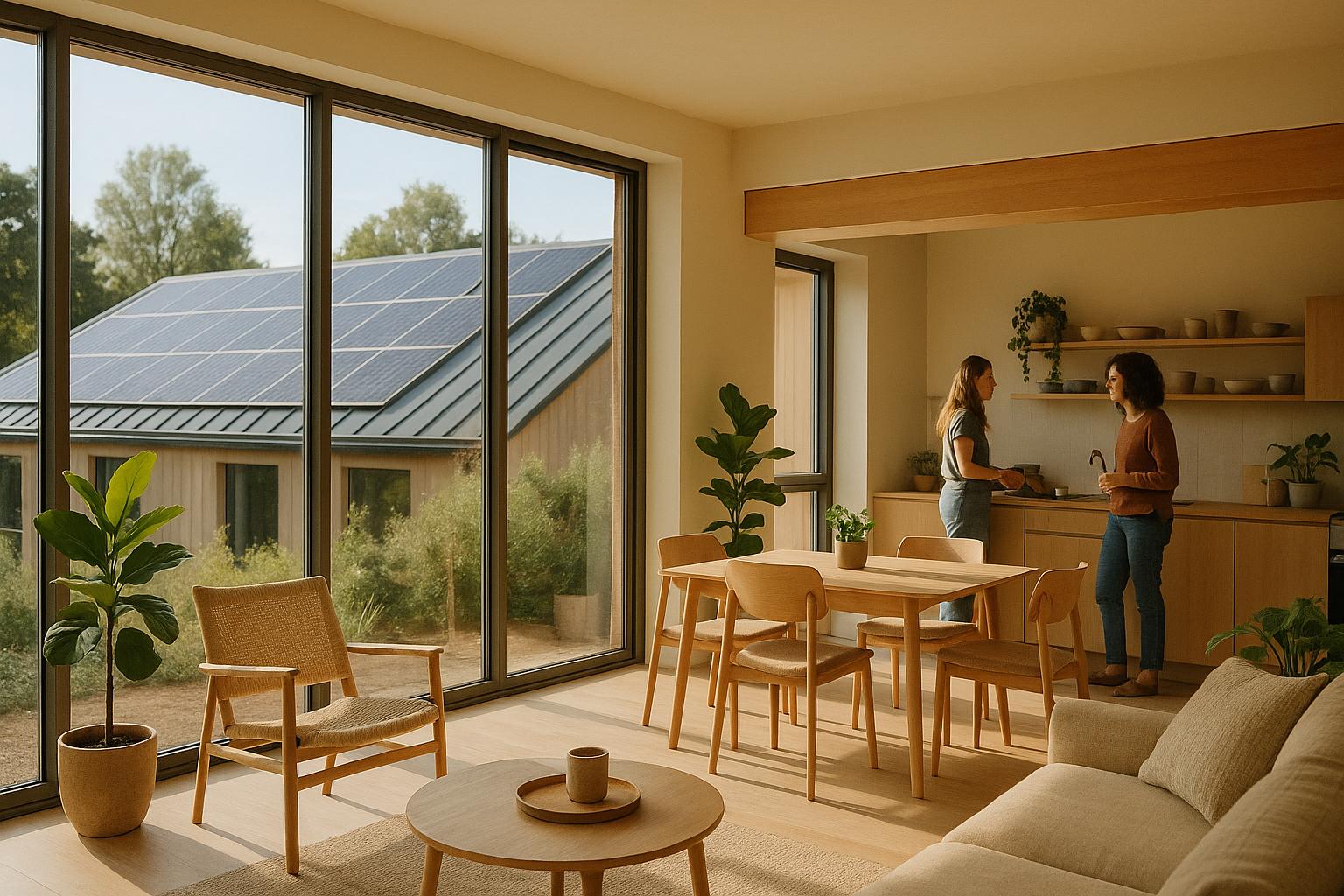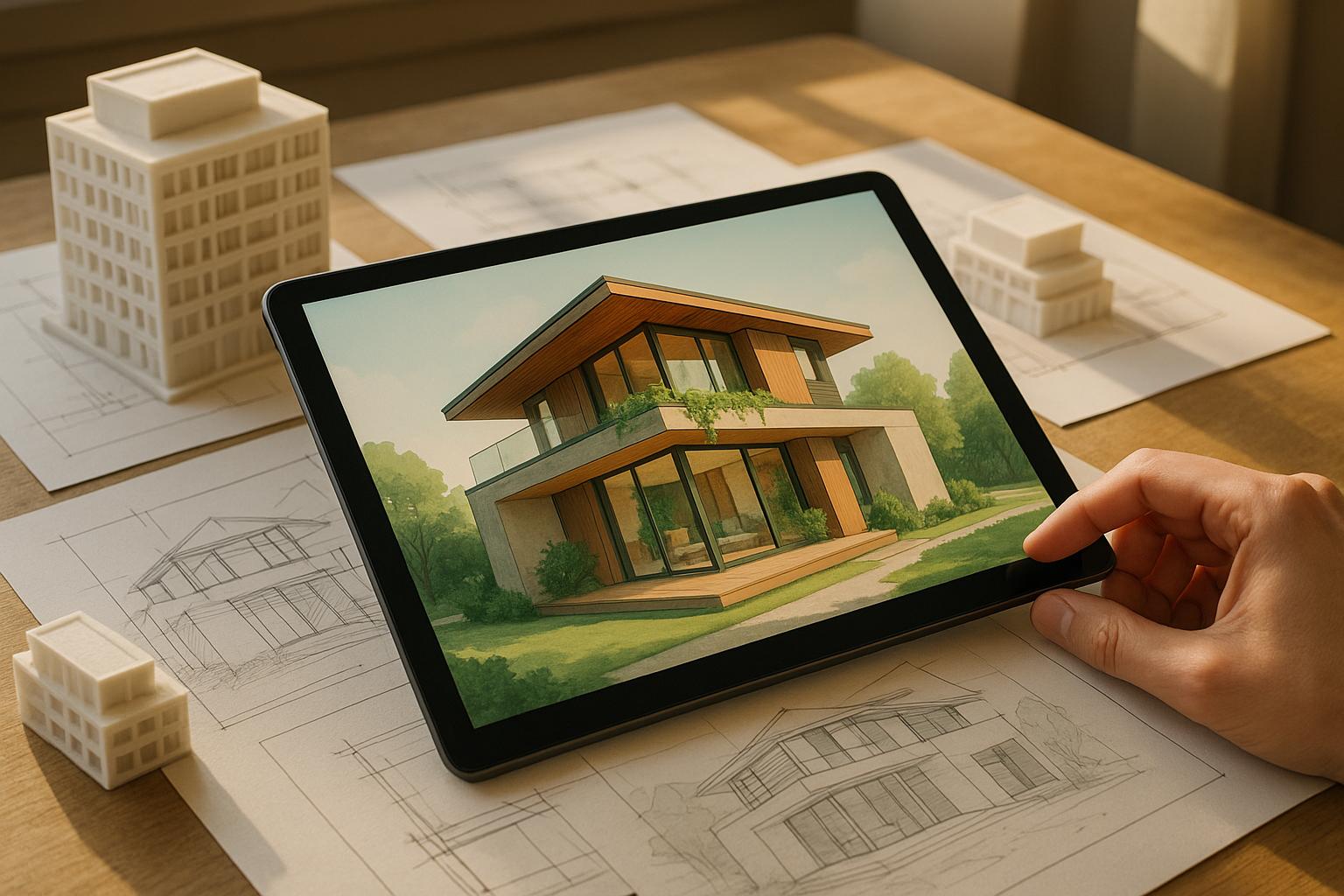Coliving spaces are uniquely positioned to save energy and reduce costs while promoting sustainable living. Here's how these shared spaces make energy efficiency easy and impactful:
- Shared Utilities: Heating, cooling, and lighting are shared, reducing waste and saving money.
- Smart Design: Efficient layouts, natural light, and proper insulation lower energy use.
- Green Technology: Solar panels, LED lighting, and smart thermostats cut energy bills.
- Resident Habits: Simple actions like unplugging devices or using water-saving fixtures amplify savings.
- Community Efforts: Workshops, energy challenges, and shared goals build a culture of conservation.
Building Energy-Efficient Coliving Spaces
Creating energy-efficient coliving spaces starts with smart design that makes the most of natural resources. By reducing energy demands through thoughtful planning, these spaces can be both sustainable and cost-effective.
Space Layout and Natural Light Planning
The way a coliving space is oriented and laid out can significantly affect its energy efficiency. Positioning the building with its longest sides facing north and south and its shortest sides facing east and west helps regulate solar exposure. This setup reduces the need for heating in winter and limits overheating during summer.
Windows play a critical role too. Strategically placing and sizing windows ensures plenty of natural light while keeping energy use in check. A great example of this principle is The Collective Old Oak in London, where large windows and an atrium design flood the interiors with daylight without sacrificing energy efficiency.
To further enhance efficiency, sealing gaps and cracks is essential. Air leaks can account for over 35% of energy loss. Using thermal mass materials - like concrete or brick - adds another layer of efficiency. These materials absorb heat during the day and release it at night, cutting down on HVAC usage.
Natural ventilation systems also contribute by using wind and thermal forces to circulate air. Operable windows allow buildings to take advantage of outdoor conditions, reducing reliance on mechanical systems.
"Good design reduces energy use and eliminates dependence on fossil fuels while improving building performance, function, comfort, and enjoyment." - AIA
Green Materials and Energy-Saving Equipment
Using energy-efficient appliances and materials can make a substantial difference. For instance, ENERGY STAR-certified equipment not only lowers energy use but also saves money. Last year, U.S. consumers saved $12 billion on utility bills thanks to these appliances, which use 10–50% less energy and water than standard models.
ENERGY STAR furnaces, for example, operate with an annual fuel utilization efficiency (AFUE) of 90% or more, making them about 15% more efficient than conventional models. Similarly, modern ENERGY STAR refrigerators consume as little as 300–500 kWh annually, a drastic improvement over older models.
Lighting systems have also evolved. LED lights with smart controls and automation adjust brightness based on occupancy and natural light, ensuring efficient use without wasting energy. Meanwhile, innovations like building-integrated photovoltaics (BIPV) and solar windows turn walls and windows into energy generators. Smart energy management systems powered by AI further optimize energy use by predicting demand and adjusting consumption in real time.
Solar Panels and Renewable Energy Options
Renewable energy sources like solar power have become a cornerstone of energy-efficient coliving spaces. Solar installations, once experimental, are now standard in premium properties. These systems can cut operating costs by up to 75%, making them a worthwhile investment.
For example, installing a 30–50 kW solar system costs between $100,000 and $200,000, with a payback period of just 3–7 years. Such systems can save $15,000–$35,000 annually and offer a return on investment of 15–25% over their 25-year lifespan.
Take Impact Hub Oakland as an example: their 250 kW solar array, installed in 2022, slashed energy costs by 85% and helped the property achieve net-zero energy status. This change also coincided with a 40% rise in membership.
When rooftop solar isn’t an option, community solar projects offer a practical alternative. These setups allow multiple households to share the benefits of a single solar installation, often saving subscribers around 15% on utility bills. For property owners, solar installations can boost property values by up to 4% and increase occupancy rates by as much as 30%. Spaces with solar features can even command rents up to 10% higher than those without.
Additional measures, like green roofs, rainwater harvesting, and comprehensive energy systems, further enhance sustainability. For instance, the ROOST Apartment Hotel in Philadelphia combines these features for a well-rounded approach. Emerging technologies, such as peer-to-peer energy sharing platforms, also allow solar producers to sell excess power directly to neighbors, turning coliving spaces into local energy hubs.
Smart Technology and Daily Energy-Saving Habits
Energy efficiency in coliving spaces thrives on a combination of cutting-edge technology and thoughtful resident behavior. While smart systems handle much of the automation, encouraging residents to adopt sustainable habits significantly amplifies the benefits.
Smart Thermostats and Automated Systems
Smart thermostats have revolutionized energy management in shared living spaces. These devices, powered by machine learning and geofencing technology, fine-tune heating and cooling schedules, reducing HVAC runtime by 45% and cutting energy costs by up to 20%. Over time, they learn household temperature preferences and use occupancy sensors to adjust settings based on real-time room usage.
"Smart thermostats can help you enhance home climate control, offering an ideal balance between comfort, energy efficiency and convenience." - Green Mountain Energy
For coliving operators, centralized control is a game-changer. With smart thermostats, entire buildings can be managed efficiently by preheating or cooling spaces during off-peak hours and scaling back energy use during peak times. This approach not only lowers operational costs but also eases strain on the power grid. For instance, Americans could collectively save up to $740 million annually by using Energy Star-certified thermostats. A real-world example is GVS Smart's intelligent thermostat system, which cut energy use by 50% in their headquarters while offering predictive maintenance alerts and insights.
Teaching Residents Energy-Saving Habits
Technology alone isn’t enough - residents’ choices play a key role in achieving maximum energy efficiency. A study of 124 households in Hangzhou, China, found that energy-efficiency education reduced electricity consumption by over 10%. Simple changes in daily habits can make a big difference.
For example, unplugging unused devices, running full laundry loads, air-drying clothes, and using microwaves or induction stoves instead of traditional ovens are effective ways to lower energy use. Additionally, small adjustments like keeping windows closed when heating systems are on ensure that automated systems operate as intended. Encouraging residents to use high-power devices during off-peak hours also helps balance energy demand.
To keep residents engaged, coliving spaces can implement ongoing education efforts - workshops, posters, or even friendly competitions - to promote energy-conscious living.
Water-Saving Fixtures and Community Gardens
Water conservation is another critical component of energy efficiency, especially since heating water accounts for a significant portion of residential energy use. Upgrading to low-flow showerheads, which reduce water flow from 2.5 GPM to as low as 1.5 GPM, can save thousands of gallons annually while cutting energy consumption for water heating.
Dual-flush toilets, which use different amounts of water for liquid and solid waste, are another effective solution. High-efficiency models use just 1.28 gallons per flush, compared to older models that require up to 3.5 gallons. Similarly, faucets with aerators limit water flow to 1.5 GPM, compared to standard faucets that often exceed 2.2 GPM.
"No matter what type of water heater you have, installing a recirculation loop so you aren't waiting on hot water is important from both a water and energy savings and customer satisfaction perspective." - Jerud Martin, co-owner of Urban NW Homes
Smart leak detectors also play a vital role, identifying leaks that could waste over 3,000 gallons annually. Beyond fixtures, community gardens equipped with smart irrigation systems offer a dual benefit: they adjust automatically to weather conditions to conserve water while providing fresh produce for residents.
Regular maintenance, water-use audits, and reclaimed wastewater systems for non-potable purposes ensure that coliving spaces remain efficient. Together, these measures create a holistic approach to energy and water conservation.
Building a Community Culture Around Energy Savings
Energy efficiency in coliving flourishes when residents work together toward sustainable practices. While automated systems and individual habits play an essential role, fostering a strong community culture takes energy savings to the next level. This requires deliberate efforts in community engagement, education, and transparency to inspire residents to actively participate in conservation. By embedding these values into the community, earlier energy-saving measures can be reinforced and sustained over time.
"Sustainable communities are defined as 'groups that promote sustainability as a way of life, contributing with direct practices and promoting the movement with education.'" - Vivarium Coliving
Group Activities and Energy-Saving Challenges
Workshops and interactive sessions are great tools for educating residents about energy conservation. Topics like zero-waste living, energy-efficient habits, and sustainable food choices help connect daily actions to the community's broader energy goals. For example, hands-on activities such as learning to read energy meters or breaking down utility bills make energy-saving concepts more relatable and practical.
Monthly energy challenges can add a fun, competitive element to conservation efforts. These challenges might focus on reducing electricity use, cutting down water waste, or achieving the lowest energy consumption per room. Real-time monitoring of progress keeps the competition engaging and encourages meaningful reductions.
Collaborative decision-making also strengthens commitment. When residents have a say in policies - like setting thermostat schedules, selecting energy-efficient appliances, or designing shared spaces such as community gardens - they feel more invested in the results. Regular meetings provide a platform for sharing tips, proposing new ideas, and celebrating collective successes.
Efforts to promote sustainable transportation can further enhance energy awareness. For instance, some coliving spaces partner with local bike programs to offer residents discounted subscriptions or provide ample bike storage. Aticco Living, for example, offers community discounts on bike rentals, while The Citylifer buildings incorporate extensive bike storage and connections to local bike-sharing networks.
Energy Reports and Resident Education
Clear and consistent communication is key to keeping energy-saving efforts on track. Transparent energy reports, shared monthly, can break down usage by common areas, individual rooms, and building systems. Reports that include comparisons - such as tracking progress over time or benchmarking against regional averages - make the data more actionable and meaningful for residents.
Digital platforms can further support these efforts by facilitating transparent reporting and enabling residents to share energy-saving tips with one another. Additionally, educating residents about waste segregation ties energy efficiency to broader environmental goals, as proper waste management reduces emissions and energy-intensive processing.
Feedback loops are essential for refining these initiatives. Surveys can uncover areas where residents need more guidance, while energy audits provide concrete insights into what’s working. This feedback can then shape future workshops and educational content, ensuring it addresses the community's specific needs.
Empowering residents to take the lead in sustainability efforts is perhaps the most impactful strategy. Allowing them to propose and manage their own projects, form sustainability committees, or access small budgets for community-driven improvements transforms passive participants into active advocates. These resident-led initiatives not only boost engagement but also create a foundation for ongoing energy efficiency improvements.
Tracking and Improving Energy Performance
Managing energy effectively in coliving spaces starts with consistent measurement and analysis. Without proper tracking, even the most well-intentioned efforts can lose momentum. Building operators and property managers rely on accurate data to make upgrades, address inefficiencies, and show progress to residents and stakeholders.
"After all, you can't manage what you don't measure!" - Building Innovation Hub
How to Measure Energy Use in Coliving Spaces
A key metric for tracking energy in coliving spaces is Energy Use Intensity (EUI), which measures annual energy consumption in kBTU per square foot. For example, in a mixed-use building with residential units and a grocery store, submetering might reveal that while the residential EUI averages 50 kBTU/SF, the grocery store's EUI soars to 250 kBTU/SF. This data helps pinpoint where efficiency efforts should focus.
Tools like submetering and Building Energy Monitoring Systems (BEMS) provide deeper insights. Submetering tracks energy use in specific areas in real time, while BEMS combine software with systems like programmable logic controllers (PLCs) and supervisory control and data acquisition (SCADA) for a more comprehensive view.
Smart meters also play a crucial role, offering continuous data on energy use, peak demand times, and opportunities for load shifting. For more granular insights, appliance-level monitors reveal the performance of individual equipment.
Even small budgets can adopt cost-effective monitoring solutions. Devices like the Pzem-004t v3 with ESPHOME cost around $7–$12, depending on the configuration, making detailed tracking accessible for smaller properties.
With these tools, operators can gather the data needed for audits and create tailored improvement plans.
Regular Energy Audits and Improvement Plans
Once energy usage is measured, the next step is conducting regular audits to identify opportunities for greater efficiency. Tracking energy data not only provides a snapshot of current performance but also lays the groundwork for audits that lead to meaningful improvements.
Professional energy audits are essential for evaluating a building's energy use, efficiency, and overall performance. These audits can uncover opportunities to reduce energy costs by 20% to 30%, with some projects achieving savings of up to 60% when recommendations are implemented.
"An energy audit is a systematic examination of a building's energy usage, efficiency, building envelope and potential areas for improvement." - Appalachian Forest National Heritage Area
The frequency of audits depends on the building’s age and past upgrades. Newer coliving spaces might need annual audits, while older properties could benefit from semi-annual evaluations to address emerging issues promptly.
Comprehensive audits often go beyond surface-level assessments, using tools like thermal imaging, blower door tests, and advanced energy modeling to detect inefficiencies such as air leaks, outdated HVAC systems, or poor lighting.
After the audit, creating a prioritized implementation plan is key. Simple fixes - like adding weatherstripping or installing programmable thermostats - can be tackled immediately, while larger upgrades, such as replacing HVAC systems, require careful scheduling to minimize disruptions for residents.
Some states offer programs to support energy efficiency improvements. For instance, Massachusetts’ Mass Save® Program provides free home energy assessments, customized reports, and rebates for implementing recommended upgrades.
Finally, post-audit monitoring ensures that improvements deliver the expected results. Continuous tracking helps identify when systems deviate from optimal performance, ensuring that investments in energy efficiency continue to pay off over time.
Getting Started with Energy-Efficient Coliving
Creating an energy-efficient coliving space starts with simple yet impactful steps that deliver quick results while paving the way for long-term improvements. Every action, no matter how small, contributes to a more efficient and sustainable living environment.
To begin, focus on straightforward upgrades that have already been successful in other eco-friendly coliving spaces. A great starting point is combining smart technology with resident education. For example, installing water-saving fixtures can instantly reduce water usage without compromising comfort.
Once these initial upgrades are in place, explore affordable renewable energy options to build on the savings. Even smaller properties can benefit from targeted renewable solutions, which can be scaled as needed.
Take a cue from Coliving.com, which emphasizes smart systems to reduce energy use. Their properties feature LED lighting and automated heating and cooling systems that adjust based on occupancy. They’ve also incorporated rainwater harvesting systems and comprehensive recycling programs with clearly labeled bins for different types of waste, making it easy for residents to participate.
Community involvement plays a key role in taking these efforts further. Organize workshops on sustainable living practices or host skill-sharing sessions where residents can exchange tips and ideas. Digital tools can also help by simplifying communication about energy-saving challenges and group initiatives, making it easier for everyone to stay engaged.
Starting your energy-efficient coliving journey doesn’t have to be overwhelming. Begin with low-cost, high-impact changes like LED lighting and basic automation. Over time, expand to renewable energy systems and advanced monitoring technologies. Combining smart infrastructure with an active, informed community creates the perfect recipe for lasting environmental and financial benefits.
FAQs
How does the design of a coliving space help save energy?
The way a coliving space is designed can significantly impact its energy efficiency, cutting down on the need for heating, cooling, and artificial lighting. For example, layouts featuring large south-facing windows take advantage of natural sunlight and warmth, reducing energy use for lighting and heating. At the same time, limiting exposure to east-west sunlight helps maintain a more stable indoor temperature.
Another key aspect of efficient design is the inclusion of shared spaces that not only encourage a sense of community but also lower overall energy consumption. By prioritizing natural light and airflow, these spaces can reduce reliance on artificial lighting and air conditioning, offering a more sustainable and budget-friendly living option for residents.
How can coliving spaces encourage residents to adopt energy-saving habits?
Encouraging energy-saving habits in coliving spaces begins with fostering a shared mindset around sustainability. Tools like smart home energy systems can play a major role by tracking and managing energy use, allowing residents to see their consumption patterns and take steps to lower utility costs. Small changes, such as installing LED lights, programmable thermostats, and energy-efficient appliances, can have a noticeable impact as well.
Educating residents is another key step. Simple actions like turning off lights when leaving a room, unplugging devices that aren’t in use, or adjusting thermostat settings wisely can go a long way. To make it fun and engaging, consider organizing community events or friendly challenges centered on energy conservation. These activities not only encourage responsible habits but also strengthen the sense of community around shared goals.
How does using renewable energy, like solar power, make coliving spaces more sustainable?
Renewable Energy in Coliving Spaces
Renewable energy, particularly solar power, is transforming coliving spaces into greener, more sustainable environments. By generating clean electricity, solar energy helps cut down on the use of fossil fuels, which means fewer carbon emissions and a reduced impact on the planet.
But it’s not just about being environmentally conscious - solar power can also lead to significant cost savings. Over time, lower energy bills make it a smart financial choice for coliving spaces. Plus, properties equipped with solar panels often see an increase in value, creating long-term economic advantages. Incorporating renewable energy not only boosts energy efficiency but also encourages a lifestyle centered around community and sustainability.






